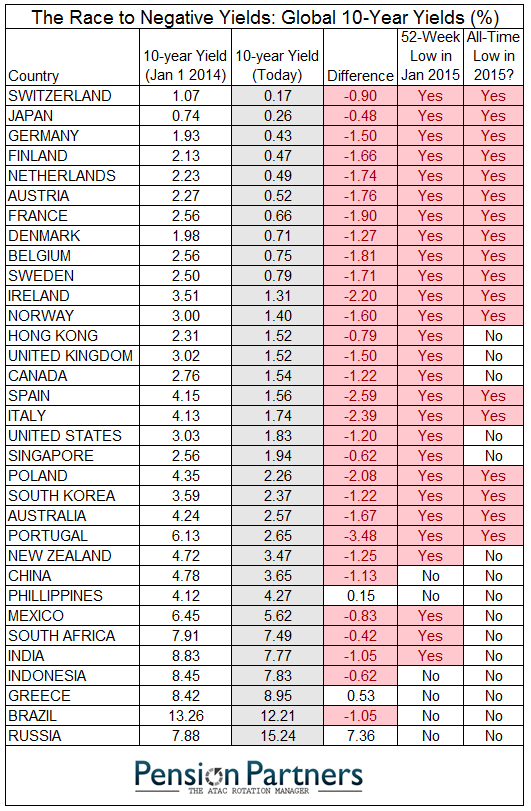The Bank of Canada is set to release its interest rate announcement and Monetary Policy Report tomorrow morning at 10 AM (ET). There is an expectation of no policy rate change and the possibility of an easing bias by market participants. The former appears a good bet given the flow of economic data recently, from employment falling by 46,000 in December to inflation remaining below the BOC’s 2% target yet remaining just within the central bank’s (1% to 3%) operating band.
The chart below illustrates three metrics, 2 observable the other an estimate, that BOC watchers pay close attention to: core inflation (in dark blue), the BOC target (i.e. policy) rate (in teal), and the output gap (in brown measured against the right Y-axis). It is the latter that should be reason enough to believe that the BOC policy rate will continue to flatline for the short term (2 years) as the slack in Canada’s economy continues to widen despite a low nominal central bank policy rate, credit extension by the banking sector, and federal and provincial governments that are running budget deficits.

My personal view is that there is no reason for the BOC policy rate to move up before the 2015 Federal elections. The Conservative government of Stephen Harper will be running, according to its Executive Director Dimitri Soudas, on a platform of supposedly ‘strong, stable leadership’ (below).
Moreover, there is the determined effort on the part of the current Conservative Federal government to ‘balance the books’ and return Canada to the promised land of budget surpluses. For a graphic on how federal governments from the time of Lester B. Pearson’s Liberals to Stephen Harper’s Conservatives have fared in this endeavour, see this graphic from the CBC.
The idea of conflating the budget of a federal government with that of a household is attractive but it doesn’t work for Canada; it can for other nations, such as those under the monetary straitjacket of European Monetary Union, but it doesn’t make sense in the Canadian context. Every nation has a particular political economy to deal with that is the legacy of history and goepolitical relations. Moreover, the nature of a nation’s currency –is it sovereign or is it shared or pegged to global reserve currency– is worth considering as is the composition of that nation’s debt ownership.
Currently, the Canadian context is one where the household sector has taken on an increasing amount of debt –both residential mortgage and consumer– that will be serviced for the coming decades and at the same time the federal government has gone into deficit spending mode since the 2008 financial crisis.

Debt to income ratio in Canada

The Bank of Canada understands this and has made the explicit assumption in previous Monetary Policy Reports that the business sector would drive growth in the economy through capital investment. That hasn’t happened.
Arguably, businesses require signals from the consumer in order to have the confidence to enact capex. Say’s Law need not apply for most companies: supply does not create its own demand. The decision in favour of capex is demand driven. Absent that effective demand, businesses can propel growth via a combination of increasing efficieny or financial engineering. The former prescription has meant offshoring, outsourcing, and hiring more workers as temporary and, increasingly, the autommation of work that requires fewer and more specialized workers (if any as the graphic below concerning the decoupling of productiviy and employment illustrates).

The latter prescription has meant, at best, bringing leverage onto a company’s balance sheet as a catalyst to translate modest top line sales growth into robust bottom line profitability and, at worst, aggressive revenue recognition to make a balance sheet and income statement look better than it really is.
Fundamentally, the deficits of one sector emerge as the surpluses of another. If we consider the debt burden of most Canadian households in terms of the stock of liabilities divided by the flow of income, we recognize that the moribund income growth entails curtailing future discretionary consumption. Canadians have brought forth a lot of future consumption by taking on mortgage and consumer debt. This requires debt servicing. Furthermore, the demographic factors facing Canadian society are a challenge that this country’s policy makers are inadequately prepared for. As the dependency ratio increases, the growth trajectory decreases: older Canadians, many of whom have saved inadequately for retirement, won’t consume as they did during their working years.
The Bank of Canada will continue to cling to the hope that the sagging loonie will spur greater demand for Canadian exports and thus make their heretofore forecasts appear more credible. This is more faith and hope then scietific reasoning as the flipside to this is that it will make capital expenditures more expensive as that is invoiced in USD. The Canadian dollar remains a petrocurrency:

CAD remains a petrocurrency
Head winds to growth:
- Household deleveraging
- Government deficit reduction
- Aging demographics
Tail winds to growth
- A depreciating currency
- Credit expansion
- Easy monetary policy
Market rates will continue to ebb and flow on the steady trickle of economic and financial data. Mortgage rates, in turn, will go up and down as a result based on the risk appetitite of the major banks. What won’t change is the policy rate: the Bank of Canada will be circumspect in articulating an easing bias as it won’t want to further inflame a housing market that is becoming expensive for most Canadians yet, in the face of the head winds facing the economy it is unlikely how the slack out of the economy will disappear over the coming years.
(Full disclosure: the author’s views are his own and he added allocation to XLB iShares in anticipation that 2014 would be a bounceback year for Canadian Long Bonds)









